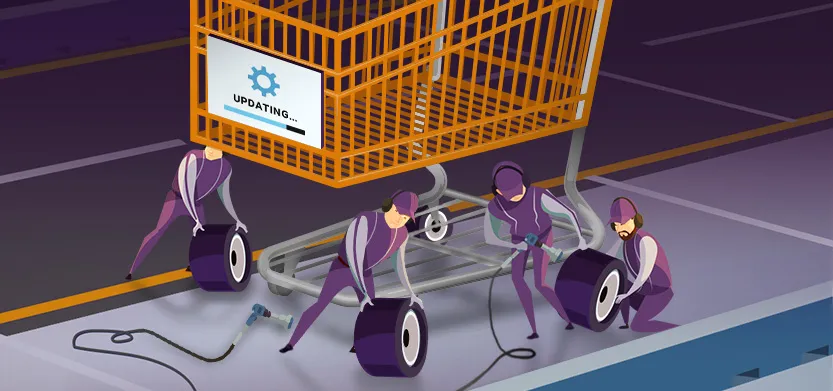
Posted in Digital Commerce, Software & Development
August 11, 2020
Ecommerce web maintenance: Best practices & costs
Key areas to ecommerce website maintenance best practices:
- Website maintenance basics. Before starting any update, perform a backup of your entire site, then you can proceed with any updates you need to get done.
- Front end website maintenance. Checking links, making sure CTA’s work, check page load time. Fix anything that needs to be repaired.
- Back end website maintenance. All security and software updates should be installed, as well as any updates to 3rd party software. Be sure to test to ensure that updated apps are still working seamlessly.
Website maintenance basics
The first step in website maintenance is to perform a backup of your site before you start any update work. When that’s done, you’ll want to update your site to the latest version of an ecommerce software or content management system, test for and fix bugs and broken links and ensure your site delivers an optimal user experience. This means your customers get the best experience shopping on your site, and you can avoid any issues that can drive customers away and damage your company’s reputation.
Putting off website maintenance may also diminish your brand’s image, potentially leading to lost sales revenue. When compared to the risk of lost sales, the upfront cost of a website update becomes a solid investment.
Front end website maintenance
Front end website maintenance relates directly to the user experience — what your site’s visitors see. If you’re noticing a dip in metrics like time spent on site, conversion rate, or sky-high bounce rates, your front end likely could use a bit of TLC.
Examples of front end maintenance tasks include:
- Fixing broken links
- Making sure your call to action buttons work
- Ensuring all forms and shopping carts perform properly
- Ensuring pages load quickly and completely
In addition to covering those basics, this is a great opportunity to optimize your content for better conversions. So take some time to go through your blog, about us, and other pages that put your company’s value props on full display. Make sure they are updated with the appropriate internal links, and that they match all current brand standards to keep your brand experience consistent across all customer touchpoints.
Back end website maintenance
Though many of the factors in the list above relate to front end website maintenance, they affect the back end, too. For instance, page load speed relates directly to user experience but may be improved with a full website update to the latest version of your ecommerce platform, the installation of AMP or other tactics ecommerce web development professionals might employ.
Back end website maintenance may require more time and professional support. In addition to focusing on back end factors that drive the front end experience, your team should perform all security and software updates, update plugins and verify any automated backup processes. Back end maintenance also includes updating third-party software and ensuring it still integrates with your site, performing seamlessly.
You’ll also want to make sure your site can handle the amount of traffic it receives, or that you anticipate you’ll receive in the near future. Website maintenance may also involve evaluating your servers and web host to see if you need to upgrade.
How much does website maintenance cost?
Costs vary based on a variety of factors, including:
- Whether you’re doing front end or back end website maintenance (or both)
- How out of date your site is currently
- The complexity of your site
- How many plugins you have
- Third-party integrations
If you have many plugins or third-party APIs, the website update may cost more. The size of your website can also drive up costs, as most website maintenance companies charge hourly rates. The larger your site, the more time the updates will take.
If your site hasn’t been updated in a while, it probably has broken links, bugs and slow-loading pages. These factors take more time to fix, driving up the cost. There’s also a greater likelihood of something going wrong on an older website that has not been maintained. The more complex the update process becomes, the higher the cost.
You might save money with a six-month or one-year contract with a website management company. But ignoring website management will ultimately cost more than whatever you might pay for maintenance.
That said, building these costs into your operating budgets is crucial. An out-of-date site can be detrimental to the success of your ecommerce business because it could result in a:
- Drop in Google rankings
- Diminished user experience
- Third-party integration issues
- Inventory tracking errors
- Cyberattacks and malware
- Website crash
- Lost sales opportunities
Is your website near end-of-life?
Sometimes, your site has grown beyond what your current ecommerce platform can deliver. It may be time for an upgrade. You can tell your website is near its end of life if it continues crashing after you’ve performed the necessary website update, if your third-party integrations don’t perform properly with your site or the site doesn’t provide the design flexibility you need. When the cost to maintain your website becomes higher than your site revenue, it’s time to consider replatforming.
Further, if your site’s architecture won’t allow you to make the creative design updates you desire for an improved user experience, it’s time for a change. An engineered ecommerce site can eliminate your replatforming woes and ensure your site is ready to grow with you.
When it's time to update, help is here
An up-to-date website can help improve conversions and customer satisfaction while increasing operational efficiency for your organization. The expert team at Acro Commerce can work with you to determine the best solution if you simply need an update or if your website has reached its end of life. Reach out today!
Dawn Allcot is a full-time freelance writer and content marketing professional specializing in technology, ecommerce, web development, personal finance, and real estate.


